Summer Study '07: What Do the Phase I Scholars Do?
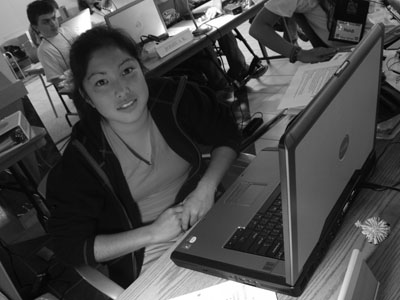
DO-IT Phase I Scholars participate in a two-week, live-in Summer Study session on the University of Washington campus in Seattle. They learn about college life; explore the Internet; interact with peers, staff, and mentors; and have fun. The DO-IT Scholars program started in 1993 as an experimental project for teens with disabilities nationwide. Now it is supported for Washington State teens by the State of Washington, the Boeing Company, and the Microsoft Corporation.
Engineering 101
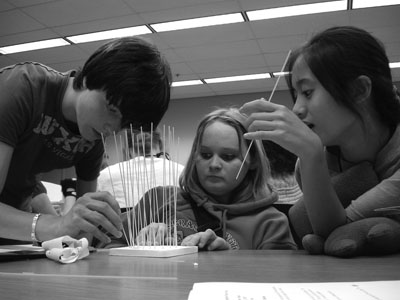
One might ask what the point of building a water tower out of spaghetti, tape, and foam board is. To find out why these structures were built, one need to look no further than The Wonderful World of Engineering class for the Phase I Scholars at DO-IT Summer Study held on the University of Washington campus. Students built teamwork skills by creating a tower that would support the most weight possible. The activity developed leadership skills as students learned how to cooperate and inspire confidence in their fellow classmates by encouraging them to voice their ideas.
The guest speaker for Engineering 101 was Frank Ashby, Director of Student and Community Relations at the U.W. College of Engineering. He explained the importance of engineering, the difference between various fields in engineering, and the ways in which engineering can be applied to today's world. DO-IT staffer Lisa Stewart said, "The purpose of the activity is to expose Scholars to the multiple fields of engineering and to help them start thinking about future careers, as well as to have some fun."
Scholars were enthusiastic about the activity and worked quickly to construct their water towers within the allotted time. The winning tower held an amazing forty-eight ounces of water.
Looking at the Scholars that attend DO-IT Summer Study, one would immediately notice that many are in wheelchairs or have another visible disability. Many also have invisible disabilities. That is because DO-IT is designed specifically to help teens with disabilities (visible and invisible) in their transition to college by building teamwork, leadership, social responsibility, self advocacy, and other skills necessary to live in the real world. DO-IT provides each Phase I Scholar with a computer, any needed assistive technology, and an Internet connection from home. New Scholars join an established e-mentoring community through which they can talk to people involved in the program such as staff, mentors, other Scholars, and Scholar graduates called Ambassadors. DO-IT also arranges internships to help Scholars discover career interests and gain valuable job experience. You can learn more about the DO-IT Scholars program at www.washington.edu/doit/programs/do-it-scholars/overview.
DO-IT is in its fifteenth year of operation and has engaged more than 300 Scholars in its Summer Study program. Many former Scholars have gone on to successful careers and continue to be involved with DO-IT through its extensive electronic mentoring community. In a nutshell, activities like The Wonderful World of Engineering teach DO-IT Scholars that a disability is not a handicap when it comes to learning and having fun.
Game Night
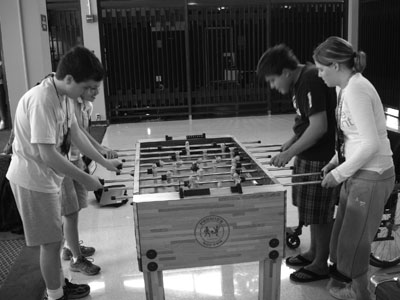
Game Night during Summer Study was exciting for DO-IT Scholars. There were lots of arcade games to choose from in the game room at the Husky Union Building (HUB) at the University of Washington in Seattle. They included Marvel vs. Capcom 2: New Age of Heroes. Scholars also enjoyed bowling, table tennis, and pool. It can safely be said that Game Night was definitely an evening activity any teen would enjoy.
Sheep Heart Surgery and Dissection
On the second day of Summer Study, we attended a class called Get to the Heart of It where we dissected and performed surgery on sheep hearts. We demonstrated the two most common heart surgeries performed today. The first was a heart bypass surgery, in which the blood flow is re-routed using a tube to act as an artery or vein. The second surgery was a modified version of a heart valve replacement. To do this, we used a piece of chalk and placed it in the heart to act as a valve.
After the two surgeries we fully dissected the sheep heart by slicing it in half and looking at the inside. We saw where the different arteries were located, and where they lead to in a sheep's body. One thing is definite: surgery of a sheep's heart is best done as a team effort, as it can be hard to work on a heart if you're a one-man (or woman) show. Being with a partner assures that everyone can participate, regardless of ability. The class was quite interesting, even if at first it seemed a little disturbing!
I Scream and Karaoke with a Birthday on Top!
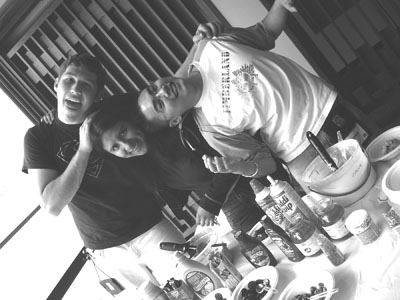
The first Saturday night at DO-IT Summer Study was an amazing Karaoke night and ice cream social with an eighteenth birthday celebration for Intern Daman all rolled up into one.
During karaoke there were lots of songs to choose from—from songs by varied artists such as The Beatles and Aerosmith to those from musicals and movies. Everyone who wanted to sing got an opportunity to do so! Even for those of us who aren't the best at carrying a tune, it was an awesome time.
During karaoke there was a big ice cream sundae bar with multiple flavors as well as all sorts of toppings, including sprinkles, fudge syrup, and whipped cream that were within reach and accessible to everyone from a seated or standing position.
The cherry on the top of the evening was celebrating Daman's eighteenth birthday. Daman's birthday made karaoke night even more fun. There was a group sing-along to "Happy Birthday" for Daman. The birthday boy was really enjoying himself too, which, of course, was the point. And that cake sure went great with the ice cream!
[See related article titled Karaoke Night '07 where Ambassador Andrew shares the poem he wrote after attending this event.]
Microsoft–What a Trip!
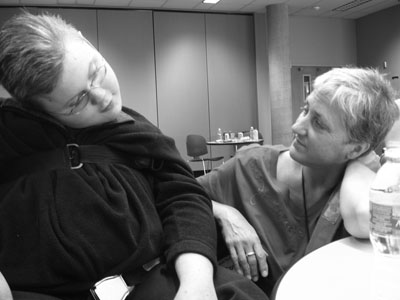
During this year's DO-IT Summer Study program, the Phase I Scholars went on a day trip to Microsoft. We learned that Microsoft is open to accommodations that their employees need and have resources available to assist them. For example, we met an employee who was blind. His guide dog and cane help guide him through the Microsoft campus. In addition, Microsoft provides guides for those with vision impairments so they can be involved and contribute fully to meetings. We also met two employees who were deaf and one who had Attention Deficit Hyperactivity Disorder. The man and woman who were deaf receive most of their projects and communication from colleagues through email. At meetings, Microsoft provides interpreters for employees who are hearing impaired. The employees with disabilities at Microsoft do their jobs like everyone else; they may just have different ways of doing things.
Microsoft buildings were accessible and have plenty of elevators. They also have automatic door openers, which allow for easy access.
After lunch, we visited the Museum Room to look at old products as well as new gadgets that Microsoft has recently come out with. These included the Zune mp3 music player and software that could tell your personality by the way you write. (It was very accurate!) We also went to the Futures Room, which showed what kind of technology people may have inside their homes in five or ten years. In this room, there were small gadgets that would be helpful for taking notes in high school or college. Finally, we said our goodbyes, loaded the bus, and headed back to the U.W. campus for dinner and a relaxing night.
Far Out!
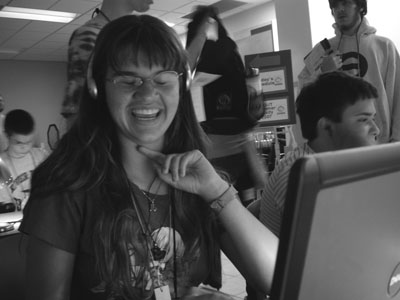
On July 19, the Phase I Scholars went to the University of Washington Astronomy Center. When we arrived, our attention was averted to the large pendulum in front of the building, swinging back and forth with the earth's rotation.
Once we made our way to the planetarium observation room, Eric Hilton, our guide, started the projection displayed on the large domed ceiling. The room became pitch black and the presentation started with the stars and sun illuminating the ceiling. Everyone watched with astonishment. The sun was setting and the stars were accelerating at a higher speed than usual, so you could see them moving. Throughout the presentation, Eric explained the constellations and the phenomenon that makes these constellations work. He told us about the constellations Ursa Major, the Big Dipper, and how to use the Big Dipper to find the North Star. Eric also told us about Orion's Belt and the red star Beetle Juice. At the end of the presentation, he explained the phenomenon that creates the Northern Lights.
After this amazing intergalactic presentation, we returned to McCarty Hall and enjoyed our evening dorm activities.
Seattle Art Museum: Home of Beauty and Wonders
The Seattle Art Museum (SAM) recently opened its doors to many new wonders, and wonders-aplenty did we Scholars find. From paintings, to statues from time long past, to modern marvels, SAM proudly boasts some of the finest collections in the Northwest. The museum hosts thousands of visitors daily who are eager to embark on travels in creativity which range from visions of exploding cars to Japanese pop art. There was so much to take in!
While the art was appealing, accommodations could be made to increase accessibility, including more hands-on exhibits for visitors with visual impairments.
Our Night at U-Village
Besides all of the studying and learning, the DO-IT Summer Study program also allows us to explore our surroundings. On our second night at Summer Study, we had the opportunity to explore the University Village, a large shopping area near campus. From browsing through Barnes & Noble to listening to the live music played in the parking lot, everyone found something to do.
Almost every place at University Village was physically accessible and included elevators and ramps where needed. People working and shopping were also willing to help. They greeted us with friendly attitudes. At the end of our field trip, we treated ourselves to ice cream at Ben & Jerry's. It was a great night and everyone had a blast.